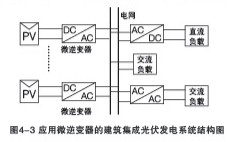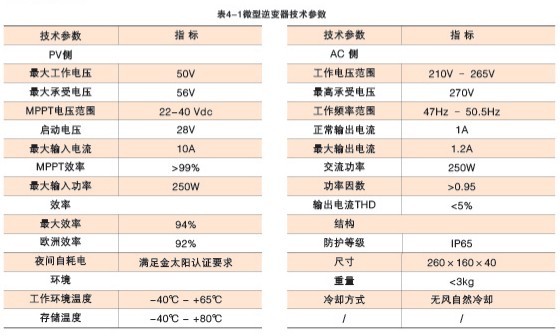1 Overview At present, China is implementing a sustainable development strategy, vigorously building a resource-conserving and environment-friendly society, and actively advocating and making efforts to promote a low-carbon economic development model. Photovoltaic power generation technology, as the most renewable energy generation technology with the characteristics of sustainable development, has been rapidly developed under the strong support of the country in recent years. As a public service institution with high energy consumption in China, the hospital will face greater pressure in the future work of energy saving, emission reduction and consumption reduction. It will actively explore the construction and development model of green hospitals, effectively improve the level of hospital construction, and promote the concept of green building. The scientific application of energy-saving technologies is particularly important. 2 Comparison between traditional inverters and micro-inverters 2.1 Traditional Inverters At present, the schematics of electrical structures commonly used in photovoltaic systems are generally centralized, string, and multi-string, as shown in Figure 4-1. In the three systems, the maximum power point tracking of the system is performed for the entire string. It cannot be guaranteed that each component is operating at the maximum power point, and the status information of each PV module cannot be obtained; on the other hand, the actual installation surface is different. The installation directions and the angles of the components are not necessarily the same. The power generation efficiency of each component is different from each other. The centralized maximum power point tracking is used to reduce the power generation efficiency of the system. The actual measured energy loss of the centralized photovoltaic system is shown in Figure 4-2. The data show that there is a 25% loss of photovoltaic energy at 3% coverage. 2.2 Micro-inverter The micro-inverter grid-connected technology proposes integrating the inverter directly with a single PV module, and providing each PV module with a separate inverter module with AC/DC conversion function and maximum power point tracking function, and directly sending the energy from the PV modules. Convert to AC power for AC load use or transmission to the grid. As shown in Figure 4-3: The use of micro-inverters instead of traditional centralized inverters has the following advantages: (1) Each micro-inverter is individually connected to one photovoltaic panel in the array. Each photovoltaic panel has independent maximum power point tracking (MPPT) control, which outputs maximum power at any time, regardless of the other panels in the array. In practical applications where shadowing, dirt accumulation, light deviation or mismatching are not ideal conditions, the micro-inverter will maximize the energy output of the entire photovoltaic array. The system's power generation efficiency has increased significantly. (2) Integrate the inverter and PV modules to achieve modular design. Failure of a single module will not affect the entire system. The design ambient temperature reaches -40 degrees to +65 degrees. The environmental rating is up to IP65. It does not occupy the installation space independently. The distributed installation is easy to configure. The application system can fully utilize the space and adapt to different installation directions and angles. The reliability is high and the extension is simple and convenient. (3) Combining the micro-inverter technology with power line carrier communication technology, the output power and status information of each micro-inverter and PV modules can be collected through the AC AC bus, which is very convenient for monitoring the entire system. The need for additional communication lines does not impose any burden on the system connection, greatly simplifying the system architecture. 3 Acrel Micro Inverter 3.1 Appearance size (unit: mm) 3.2 Technical parameters 4 Micro-inverter applied to hospital building The DC power generated by solar panels is converted into AC power through inverters. It does not pass the energy storage of the battery and is directly passed through the grid-connected inverters. The power is sent to the grid. The efficiency is higher, the stability is better, and the economic efficiency is better. Facilitate the promotion and application in the city. The hospital building accounts for about 40% of the total energy consumption of the building's heat energy consumption. The hospital building has constant temperature water 24 hours a day, and the daily hot water is relatively large. According to the statistics, it is 30 tons to 500 tons. The energy consumption of hospitals is very large. In the era of “energy reformâ€, hospitals, the major energy consumers, bear the brunt of the reforms and will certainly be at the forefront of reforms*. Solar energy is the green energy of the 21st century. It must be used in hospitals. Solar power accounts for a large area, so solar energy will certainly be used in hospitals. In addition, micro-inverters have many advantages over traditional inverters. Micro-inverters will surely shine. 5 Summary Solar inverters are a key component of the entire solar energy system. Solar cell panels, partial shadows, different tilt angles and orientation, dirt, different ageing, small cracks, and different temperatures of different photovoltaic panels are likely to cause system mismatches that result in reduced output efficiency, leading to overall The output power is greatly reduced. This is a problem that centralized inverters cannot solve. Ankerui developed the AMI-250 micro-inverter, which can be installed with solar panels on the roof, exterior wall, etc. of hospital buildings without the need for separate installation space. Vehicle Greases,Automotive Grease,Automotive Lubrication,Car Wheel Bearing Grease Hangzhou Xingang Lubrication Technology Co., Ltd. , https://www.newlubes.com


